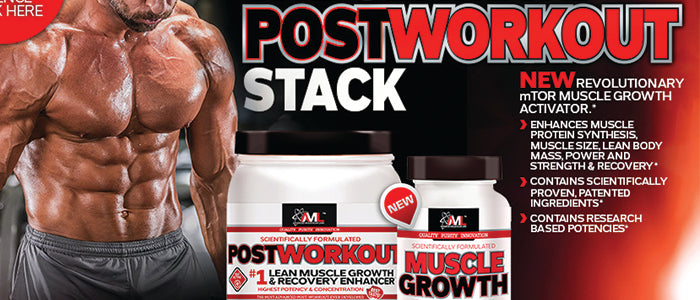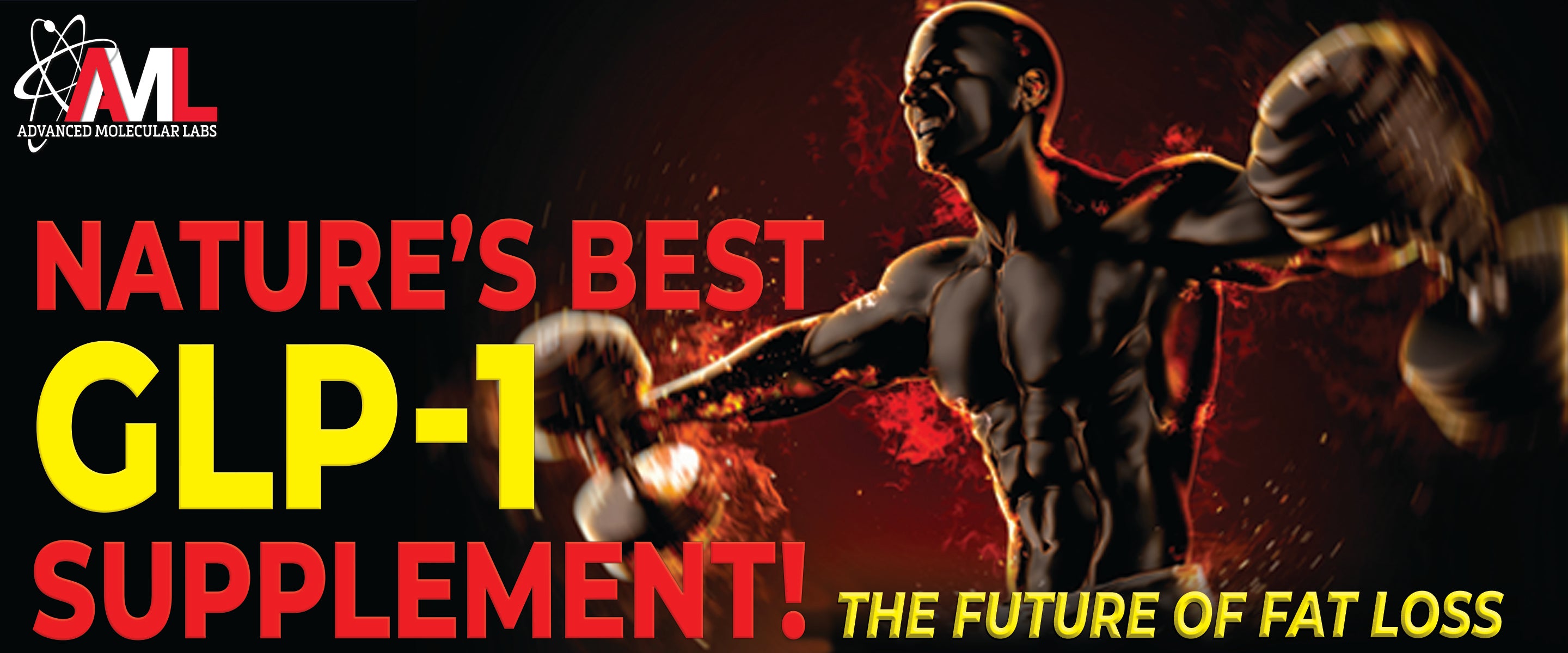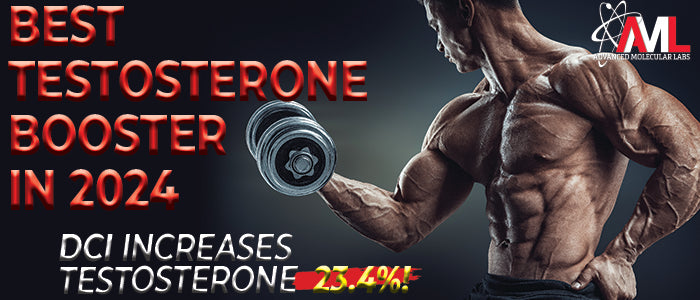


THE BEST POST-WORKOUT MUSCLE GROWTH STACK
Ever since the discovery of the chemical structure of DNA in 1953, man has been on a relentless quest to find ways to enhance the body’s production of anabolic hormones, specifically in relation to its effects on the building muscle after weight training - otherwise known as hypertrophy. Numerous “groundbreaking” ingredients have come and gone over the years, often will much less bang than they promised. However, more recent research has unveiled that consuming certain all-natural compounds immediately post workout can enhance muscular growth to remarkably high levels. AML’s team of formulators has sorted through the science to craft two products that when taken together for The Ultimate Post-Workout Stack!
AML Post Workout and AML Muscle Growth will enhance muscle growth, lean body mass, strength, power and recovery like no other post-workout stack ever has before. These two cutting-edge products are chock-full of a anabolic compounds, all in clinically efficacious doses. Just to highlight a few, stacking AML Post Workout and Muscle Growth gives you:
- 5g Leucine
- 5g Creatine Monohydrate
- 2.5g Betaine
- 3g HMB
- 750mg Phosphatidic Acid
- 4,000 IUs Vitamin D3
This exceptional mixture of research-backed ergogenics was designed to precisely trigger an anabolic environment that will generate massive muscle growth.
Boost Muscle Growth & Prevent Muscle Breakdown With Leucine and HMB
Leucine is the most well known, and well researched, of the Branched-Chain Amino Acids (BCAAs). It’s been shown to stimulate muscle protein synthesis and inhibit muscle protein breakdown by directly activating the mTOR pathway. In fact, one study by Walker et al.1 showed that leucine consumption, immediately post workout, increased mTOR activity for several hours after training— leading to greater muscle protein synthesis when compared to a second group that did not take leucine.
Additionally, one of Leucine’s primary metabolites, HMB, also triggers considerable muscle growth. The difference between the two is that HMB supports muscle growth by reducing muscle protein breakdown instead of stimulating muscle protein synthesis like leucine does. In fact, one study found that 3g of HMB (the precise dose included in AML Muscle Growth!) attenuated muscle protein breakdown by a whopping 57 percent.4
Other research gives evidence of HMB’s ability to reduce muscle protein catabolism -- ie muscle breakdown -- and shows that HMB actually increases muscle growth and strength when combined with resistance training.5 As a result, consuming both Leucine and HMB not only drive the synthesis of new muscle protein but will also prevent the breakdown of existing muscle protein, resulting in extraordinary levels of hypertrophy - sheer muscular growth.
But that's only the start - there are more can't-miss ingredients, some of them familiar and some of them new:
Build Muscle With Creatine
No other single ingredient has been more thoroughly studied and safely proven successful than Creatine Monohydrate. The vast array of studies on this clinically-backed muscle-builder demonstrate that creatine supplementation increases power output during intense exercise while also stimulating muscle growth.6
The unique capacity of creatine to boost size and power stems in part from creatine’s ability to rapidly reverses the depletion of muscle cell energy (ATP) during muscular contraction. This ultimately recharges energy levels within the muscle cell faster, prolonging muscular contraction for superior muscle growth and performance.7 Lastly, creatine has also been shown to stimulate new muscle cell formation8 and increase muscle protein synthesis.9 All of these combined effects make Creatine the hallmark ingredient of safe, natural muscle growth and no athlete should miss out on its incredible effects.
Prevent Muscle Atrophy With Leucine, Creatine and HMB
We all know that resistance training breaks down muscle tissue, but do you know why? It all traces back to a powerful, little gains-destroying protein called myostatin. This tissue-depleting molecule prevents muscle growth by inhibiting the formation of new muscle fibers10, while also decreasing mTOR-driven muscle protein synthesis.11 High levels of myostatin equate with low levels of gains. So how do we keep it at bay?
This question has led researchers to hunt for a solutions to limit the deleterious effects of myostatin and keep the growth coming year after year. A recent study by Mobley et al.12 showed that a mixture containing leucine, calcium-HMB, and creatine monohydrate reversed myostatin-induced atrophy in muscle cells. Because of the great potential of this combination of ergogenics, stacking AML Post Workout and AML Muscle Growth Post-Workout Stack — which provides all three compounds— will limit myostatin’s effectiveness opening the door to unprecedented levels of muscle growth!
Pump Up With Betaine
Betaine— also known as trimethylglycine— is a natural compound found in the cell that protects the cell against dehydration by increasing cellular water retention via osmosis. Betaine’s ability to function as an cell volumizer supports muscle hypertrophy by causing the muscle fiber to swell. In fact, research has shown that muscle cell swelling stimulates protein synthesis and decreases protein breakdown, resulting in muscle growth.13,14
Additionally, betaine also plays a key role in the biosynthesis (formation) of creatine— implying that betaine should mimic the muscle-building effects of creatine to some degree. Indeed, studies have proven that betaine ingestion -- preferably the clinically-verified 2.5 grams per day -- does significantly increase anaerobic power in the bench press and squat. This is conceivably because of betaine’s ability to increase creatine levels within muscle tissue.15
Unchained Muscle Growth With Vitamin D3 & Leucine
Vitamin D has traditionally only been thought to be important for bone health; however, more recent research on this critical vitamin have shown that it actually functions as a powerful prohormone that drives muscle growth by regulating the expression of many important muscle-building genes, namely testosterone.16,1718
Many athletes have a love-hate relationship with carbohydrates. Ideally, we want to take them and get them shuttled into the muscle cells, not fat! Thankfully, a separate function controlled by vitamin D enhances insulin sensitivity by increasing the expression of the insulin receptor gene. This results in more insulin receptors on the surface of the muscle cell, which causes a more sensitive signaling response to insulin. Ultimately, the enhanced insulin response drives more muscle growth and carbohydrate intake into the actual muscle -- something every athlete wants!
Other recent studies have also shown the capacity of vitamin D3 to increase insulin receptor levels within the muscle cell, providing a more robust anabolic response to leucine intake. A study by Salles et al.19 looked at the influence that vitamin D3 had on leucine-activated insulin signaling in muscle cells. Since we know that leucine consumption drives muscle protein synthesis, the researchers wanted the see if vitamin D3 could enhance leucine activation of the insulin pathway.
As it turns out, vitamin D3 does in fact enhance the ability of leucine to activate the insulin signaling process, and it also increases the rate of muscle protein synthesis. This is one of those times where the results backed up the theory: there was an increase in insulin signaling and muscle protein production and it was mainly due to the increased activity in these insulin receptor genes. The end result meant that vitamin D3 yielded more insulin receptors embedded within the muscle cell, fostering a greater anabolic response within the muscle cell.
Point being? Don't miss out on your Vitamin D3 if you want to make the best use of your food and testosterone supply. Too many workout stacks don't include it, but AML is not so short-sighted. Along with Leucine makes a fantastic 1-2 punch for gaining lean muscle.
Advanced mTOR-driven Muscle Growth With Phosphatidic Acid
Now it's time to introduce you to a new supplement ingredient that you may not have heard of, but it's one many fitness fanatics are calling the "next big thing".
Phosphatidic Acid (PA) is a phospholipid found in the cell membrane involved in many different cell signals, including the primary one that stimulates muscle growth. Several recent scientific studies have shown that an increase in PA is responsible for the activation of mTOR signaling during and after resistance exercise. The big surprise is that it works alone, and without increased IGF-1, as was previously thought. A study by O’Neill et al.20 showed that incubating muscle cells with PA does induce an increase in mTOR signaling, and increased mTOR signaling means more muscle cell activation and growth.
The Phosphatidic Acid Muscle Growth Study: A massive success
With the knowledge that PA increases mTOR-driven muscle protein synthesis, another group of researchers tested whether PA could actually increase muscular size and strength in trained athletes - the holy grail of natural supplements. In this study by Hoffman et al.21, the team investigated the influence that PA had on strength in 16 resistance-trained subjects. The subjects were split into two groups, with one receiving 750mg of PA per day and the other group taking a placebo.
During the experiment, each subject lifted weights four days a week at 70% of their one-repetition maximum (1RM) for all lifts during the entire eight-week trial period. At the end of the experimental period, each subject was tested for strength and body composition. The results showed that subjects ingesting 750mg phosphatidic acid demonstrated a 12.7% increase in squat strength and a 2.6% increase in muscle mass! The group consuming a placebo, on the other hand, showed much less improvement in squat strength and virtually no increase in muscle mass.
These results show that the real-life results back up the theory behind them, making Phosphatidic Acid your next can't-miss supplement.
Taking everything into consideration, a proper Post Workout Stack will activate the mTOR pathway via two separate ways: one by an insulin-independent way using PA, and the other in an insulin-dependent fashion by compounds such as leucine. For this reason, AML has included both PA and Leucine as components in The Ultimate Post Workout Stack, and athletes with any goal and any diet type can get in on the gains.
Remember, muscle is broken down during training, and it’s only when the weights are set down that recovery and most importantly, repair and growth can occur. Advanced Molecular Labs has done the latest research for you and has taken the guesswork out of what to consume following intense exercise. The AML Post Workout and AML Muscle Growth Stack provide everything you would need to recover faster and see superior growth!
References:
1. Jiang Y, Singh P, et al. Opposite roles of myocardin and atrogin-1 in L6 myoblast differentiation. J Cell Physiol 2013;228, 1989-1995.
2. Wilkinson DJ, Hossain T, et al. Effects of leucine and its metabolite beta-hydroxy-beta-methylbutyrate on human skeletal muscle protein metabolism. J Physiol 2013;591, 2911-2923.
3. Nissen S, Sharp R, et al. (1996). Effect of leucine metabolite beta-hydroxy-beta-methylbutyrate on muscle metabolism during resistance-exercise training. J Appl Physiol 1985;81, 2095-2104.
4. Heaney R.P. Vitamin D in health and disease. Clin J Am Soc Nephrol 2008;3, 1535-1541.
5. Norman AW. From vitamin D to hormone D: fundamentals of the vitamin D endocrine system essential for good health. Am J Clin Nutr 2008;88, 491S-499S.
6. Reichel H, Koeffler HP and Norman AW. The role of the vitamin D endocrine system in health and disease. N Engl J Med 1989;320, 980-991.
7. Salles J, Chanet A, et al. 1,25(OH)2-vitamin D3 enhances the stimulating effect of leucine and insulin on protein synthesis rate through Akt/PKB and mTOR mediated pathways in murine C2C12 skeletal myotubes. Mol Nutr Food Res 2013;57, 2137-2146.
8. O'Neil TK, Duffy LR, et al. The role of phosphoinositide 3-kinase and phosphatidic acid in the regulation of mammalian target of rapamycin following eccentric contractions. J Physiol 2009;587, 3691-3701.
9. Hoffman JR, Stout JR, et al. Efficacy of phosphatidic acid ingestion on lean body mass, muscle thickness and strength gains in resistance-trained men. J Int Soc Sports Nutr 2012;9, 47.




